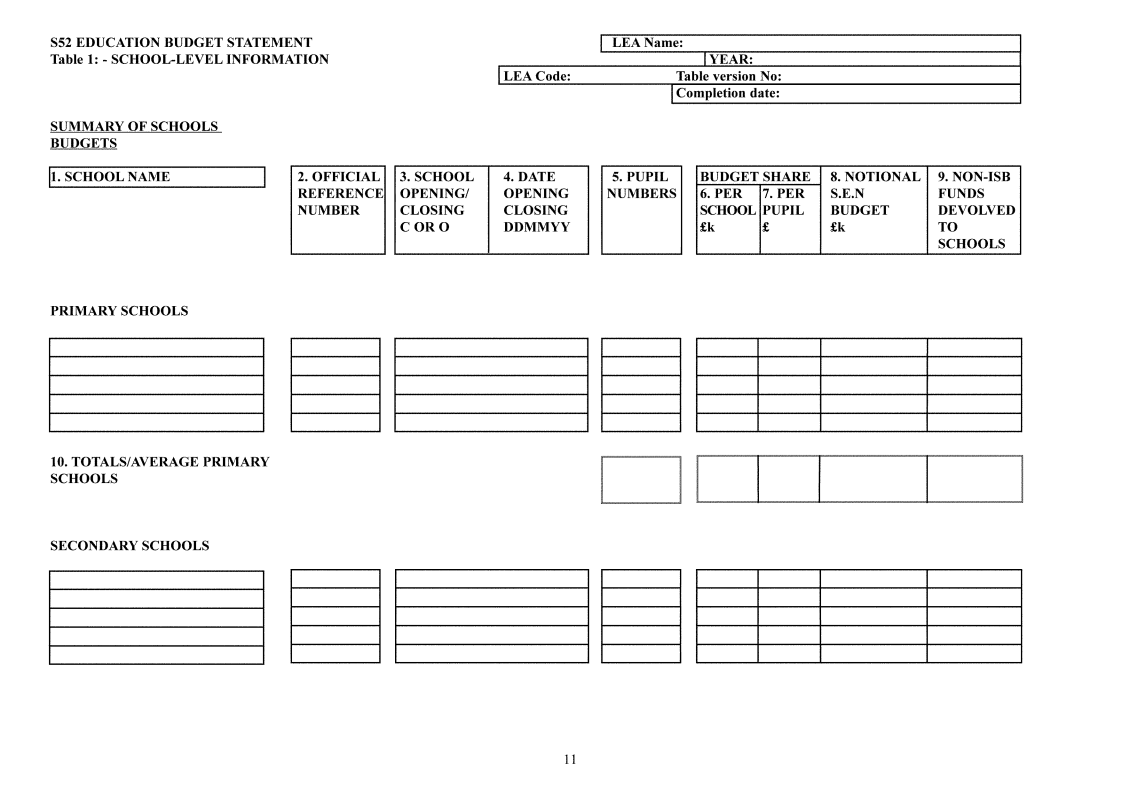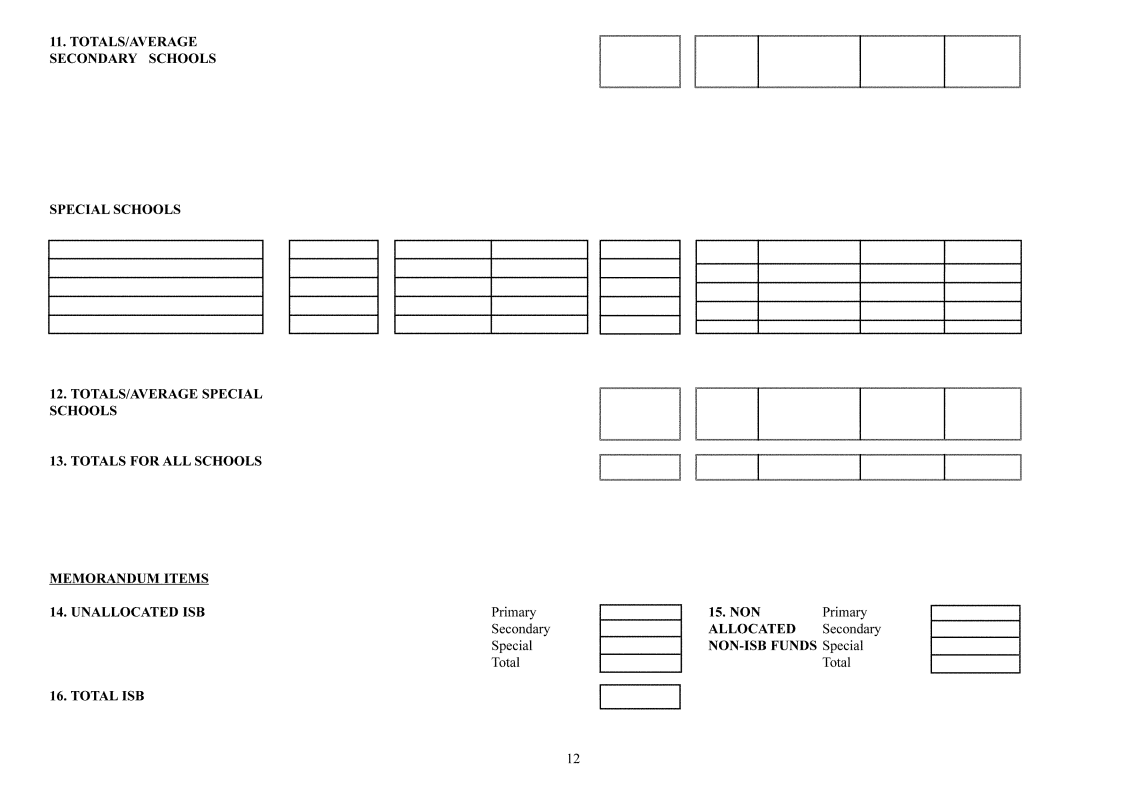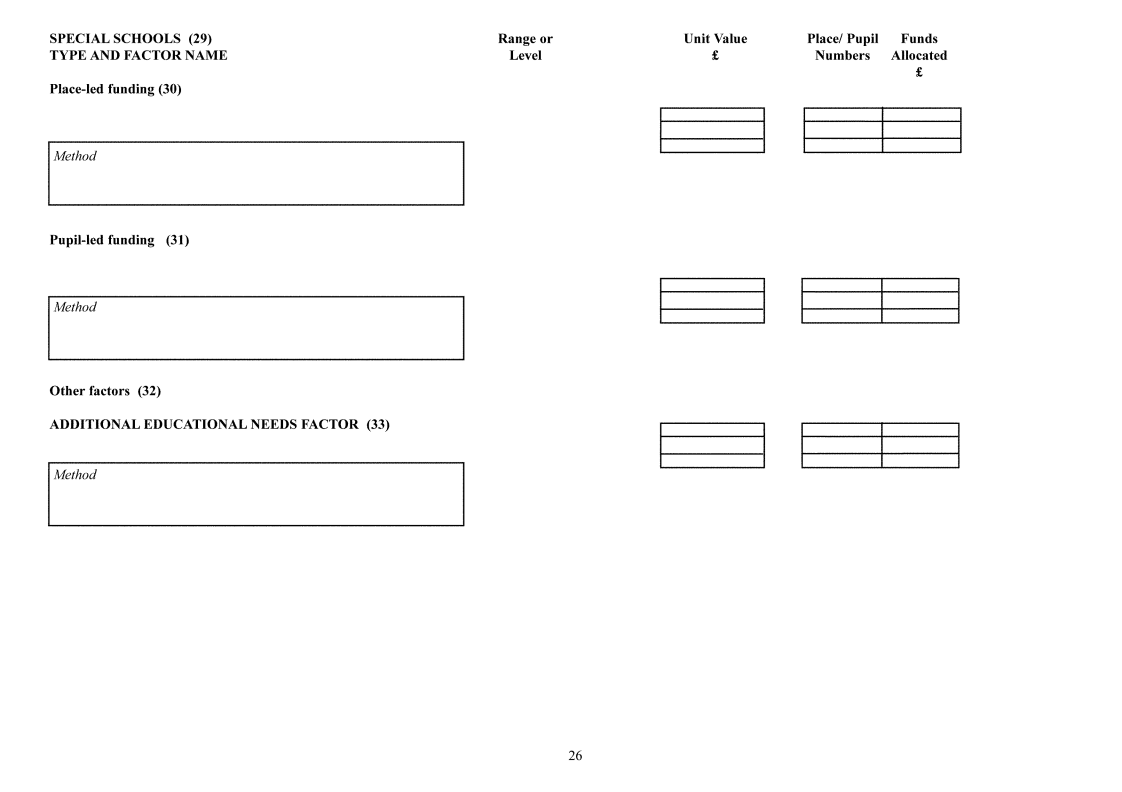SCHEDULE 1PART I OF BUDGET STATEMENT
Part 1 of a budget statement (school level information) must be in the following form and in accordance with the notes. Both the English and Welsh versions of the form must be completed.
NOTES TO PART 1
The numbered notes below refer to the items in the table bearing the corresponding number.
1
Enter the names of all schools maintained or to be maintained by the LEA in the financial year in the following order—
a
primary schools;
b
secondary schools;
c
special schools.
2
Opposite the name of each school, enter in Column 2 that school’s official reference number.
3
Enter in Column 3, opposite the name of each school, the letter “C” if the school is to close during the financial year and the letter “O” if the school is to open during the financial year; otherwise leave blank.
4
Enter in Column 4 the date that such a school is intended to close or to open, as the case may be; otherwise leave blank.
5
Enter in Column 5, opposite the name of each school—
a
in the case of a primary or secondary school, the number of registered pupils at the school required under the allocation formula to be used for the initial determination of that school’s budget share; or
b
in the case of a special school, the number of places at the school funded by the LEA for the financial year.
In the case of a school that will be open for part of the year only, the number determined in accordance with (a) or (b) above must be reduced to reflect the proportion of the year that the school is to open. For example, if a school is expected to open for 7 months of the financial year, the number shown should be the number of pupils multiplied by 7, then divided by 12.
6
Enter in Column 6, opposite the name of each school, the whole of the school’s budget share. For schools only open for part of the year, the actual budget share given to the school should be shown.
7
Enter in Column 7, opposite the name of each school, the planned expenditure per pupil at the school calculated by dividing the amount entered in accordance with note 6 by the number of pupils or places for the school entered in accordance with note 5.
8
Enter in Column 8, opposite the name of each school (other than a special school), the amount of that part of the school’s budget share which results from the application of the allocation formula in relation to the school’s estimated need to make special educational provision.
9
Enter in Column 9, opposite the name of each school, the amount of planned additional funding (including grants) proposed to be allocated to the school otherwise than as part of the school’s budget share.
10
Enter in line 10 in each of Columns 5, 6, 8 and 9 the aggregate of the numbers entered in each of those columns in respect of primary schools and in column 7 the average of the numbers entered in that column in respect of such schools.
11
Enter in line 11 in each of Columns 5, 6, 8 and 9 the aggregate of the numbers entered in each of those columns in respect of secondary schools and in column 7 the average of the numbers entered in that column in respect of such schools.
12
Enter in line 12 in each of Columns 5, 6, 8 and 9 the aggregate of the numbers entered in each of those columns in respect of special schools and in column 7 the average of the numbers entered in that column in respect of such schools.
13
Enter in line 13 in each of Columns 5, 6, 8 and 9 the aggregates of the numbers entered in each of those columns in accordance with notes 7 to 12, and in column 7 the average of the numbers entered in that column.
14
Enter in line 14 the amount of the ISB not allocated to schools' budget shares at the beginning of the financial year , giving an estimated split between primary, secondary and special schools and giving a total.
15
Enter in line 15 the total amount of funding of the kind referred to in Note 9 which the LEA plan to allocate to the school but which is not allocated at the beginning of the financial year, giving an estimated split between primary, secondary and special schools and giving a total.
16
Enter in line 16 the aggregate of the numbers entered in column 6 in accordance with Note 13 and in the “total” box in accordance with Note 14.
SCHEDULE 2PART 2 OF A BUDGET STATEMENT
Part 2 of a budget statement (information about the allocation formula) must be in the following form and in accordance with the notes. Both the English and Welsh versions of the form must be completed.
NOTES TO PART 2
INDIVIDUAL SCHOOLS BUDGET — FUNDING FACTORS1
The numbered notes below refer to the items in the table bearing the corresponding number. Where an authority do not intend to make any financial provision for any matter listed in the table a zero must be entered at the appropriate place.
The table must list and include a description of each factor used including the full methodology of the factor. This description should be provided in the table in the relevant box headed “Method”.
PRIMARY AND SECONDARY SCHOOLS
2
3
Enter here a description of the method used to calculate from the pupil numbers taken from the annual school census, the number of pupils to be taken into account in allocating funding through the authority’s allocation formula.
4
A general column heading for the type and factor name used to determine school budgets.
5
Enter in this column (5) opposite each factor in column (4) and in ascending order each relevant year, age group, year group, subject taught or band based on assessment of need applicable in accordance with the allocation formula for primary and secondary schools, specifying separately any specific separate categories for pupils in nursery classes or for those funded according to the subject being studied. Where the number of pupils in nursery classes is weighted then the weightings must be shown and a note provided to explain whether numbers are the actual numbers or based on full-time equivalents. Enter also at the appropriate sections of the table the range or levels relating to site specific and school specific factors.
6
Enter in this column (6), opposite each entry in column (4), the amount attributed to each pupil in that year, age group, year group, subject taught or band based on assessment of need.
7
Enter in this column (7) opposite each entry in column (4)—
a
the total number of registered pupils in that year, age group or year group at primary and secondary schools taken into account in the allocation formula but ignoring any weighting; or
b
the number of places, in the case of provision of places in schools which the authority recognise as reserved for children with special educational needs, or for children in nursery classes.
8
Enter in this column (8), opposite each entry in column (4), the amounts produced by multiplying the amount in column (6) by the number in column (7).
9
Enter in this column (9) the aggregate of the amounts in column (8) expressed as a percentage of the amount referred to in line (32).
10
A sub-heading for the factors which allocate the ISB by reference to the numbers of registered pupils at primary and secondary schools and their ages (or age group or year group to which they belong), their attendance at a nursery class, their subjects of study or any special educational needs they may have or are to be treated as having for the purposes of the application of the allocation formula, so that each pupil within a given category attracts equal amounts regardless of the school which he or she attends.
11
A heading for the entries to be made under the age-weighted funding subsection of the table.
12
Enter in this column (12) the amounts which represent the weighting given according to age (including key stage or year group), whether a pupil is provided with nursery education or the subject or course of study in the case of pupils in a sixth form.
13
Enter here a description of the method used to operate the factor, explaining variations in level of provision which pupils or their schools may attract.
14
Enter here the aggregate of the numbers in column (7), and the aggregate of the amounts in column (8), separately for primary schools, secondary schools and give a total.
Pupil-led SEN funding
15
Enter in this column each factor, relating to pupils with statements, which allocates the ISB by reference to the numbers of registered pupils at primary and secondary schools and any special educational needs they may have or are to be treated as having for the purposes of applying the allocation formula.
16
Enter in this column each factor relating to pupils without statements, which would fall to be entered in column (15) if it related to pupils with statements.
Place-led SEN funding treated as pupil-led17
Enter in this column each factor (other than those referred to in notes (10) to (16) above) which allocates the ISB on the basis of the relative needs of individual primary and secondary schools to incur expenditure in making special educational provision for places for pupils with special educational needs.
Other funding treated as pupil-led18
Enter in this column (18) each factor (other than those referred to in notes (10) to (17) above) in accordance with which the same funding is allocated for pupils of the same age irrespective of the nature of the school which they attend.
Total primary and secondary funds treated as pupil-led19
Enter here the aggregate of the amounts entered in the total boxes in lines (11), (15), (16), (17) and (18), in accordance with note (14) separately for primary schools, secondary schools and in total and the aggregate of the percentages entered in column (9).
Excess SEN funding for pupils without statements20
Enter in this column each factor relating to pupils without statements of special educational needs which would fall to be entered in column (16) above but for the limiting effect of regulation 22(d) of the 1999 Regulations.
OTHER FUNDING21
A sub-heading for the factors which allocate the ISB by reference to factors other than those referred to in notes (11) to (18). All factors in this section must be allocated to one of the following groups:
Additional educational needs,
site specific, or
school specific.
Additional educational needs factor22
Enter in this column (22) each factor in accordance with which amounts are allocated to primary and secondary schools for additional educational needs.
Site specific factors
23
Enter in this column (23) each factor in accordance with which amounts are allocated to primary and secondary schools by reference to a school’s buildings or grounds.
24
Enter in this column (24), opposite each unit of measurement described in columns (23), (25) and (26), the number of units in question.
School specific factors25
Enter in this column (25) each factor in accordance with which amounts are allocated to primary and secondary schools by reference to a school’s characteristics.
Budget adjustments26
Enter in this column (26) each factor in accordance with which amounts are allocated to primary and secondary schools pursuant to any provisions of the the 1999 Regulations dealing with budget adjustments. Include any adjustments to reflect retrospective pupil number adjustments including excluded pupils.
Unallocated reserve27
Enter here the amount of that part of the authority’s ISB retained in respect of primary and secondary schools and not allocated at the beginning of the financial year. Show the amounts separately for primary schools, secondary schools and give a total.
TOTAL FUNDS AVAILABLE TO MAINSTREAM SCHOOLS28
Enter here the aggregate of the amounts entered in accordance with notes (19), (20), (22), (23), (25), (26) and (27), separately for primary schools, secondary schools and in total.
SPECIAL SCHOOLS29
A general heading for the schools to which this section of the table relates.
Place-led funding30
Enter in this column (30) the type of factor and factor name used to allocate the ISB to special schools by reference to the numbers and kinds of places they provide.
Pupil-led funding31
Enter in this column (31) each factor in accordance with which amounts are allocated to special schools by reference to the numbers and kinds of pupils at the school.
Other factors32
A sub-heading for the factors which allocate the ISB to special schools otherwise than by reference to the number of places provided, or registered pupils at such schools. All factors in this section must be allocated to one of the following groups:
Additional educational needs,
site specific, or
school specific.
Additional educational needs factors33
Enter in this column (33) each factor in accordance with which amounts are allocated for additional educational needs.
Site specific factors34
Enter in this column (34) each factor in accordance with which amounts are allocated by reference to a special school’s buildings or grounds.
School specific factors35
Enter in this column (35) each factor in accordance with which amounts are allocated by reference to a school’s characteristics.
Budget adjustments36
Enter in this column (36) each factor in accordance with which amounts are allocated to special schools pursuant to any provisions of the 1999 Regulations dealing with budget adjustments.
Unallocated reserve37
Enter here the amount of that part of the authority’s ISB retained in respect of special schools and not allocated at the beginning of the financial year.
Total funds allocated to special schools38
Enter here the aggregate of the amounts entered in accordance with notes (30), (31), (33), (34), (35), (36) and (37).
TOTAL FUNDS AVAILABLE TO ALL SCHOOLS (ISB)39
Enter here the aggregate of the amounts entered in accordance with notes (28) and (38).
ANNEX TO PART 2
An authority may include in the Annex any relevant information in addition to that required to be included in the table.
SCHEDULE 3PART 3 OF A BUDGET STATEMENT
The authority must set out in respect of each school which they maintain, all factors indicated in Part 2 of the budget statement, together with such other information referred to in that Part as applies in relation to the application of those factors to schools.
Sub-totals shall be provided for each school indicating the aggregate of amounts allocated to that school under each of the following categories:
Mainstream Schools
1
Age-weighted funding
2
SEN to include
pupils with statements of special educational needs
pupils without statements
place-led funding treated as pupil-led
3
Other pupil-led funding
4
Additional educational needs
5
Site-specific factors
6
School-specific factors
7
Budget adjustments
8
Total share of the ISB (Mainstream)
Special Schools
9
Place-led funding
10
Pupil-led funding
11
Additional educational needs
12
Site-specific factors
13
School-specific factors
14
Budget adjustments
15
Total share of the ISB (Special)
Where a factor does not apply to a particular school a zero must be entered against that factor.







